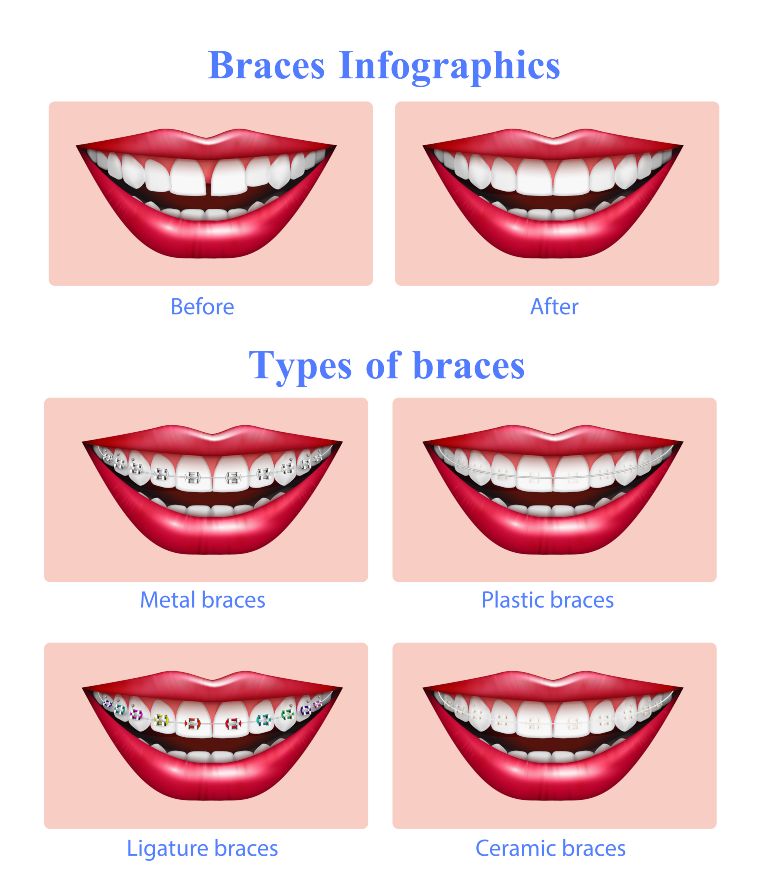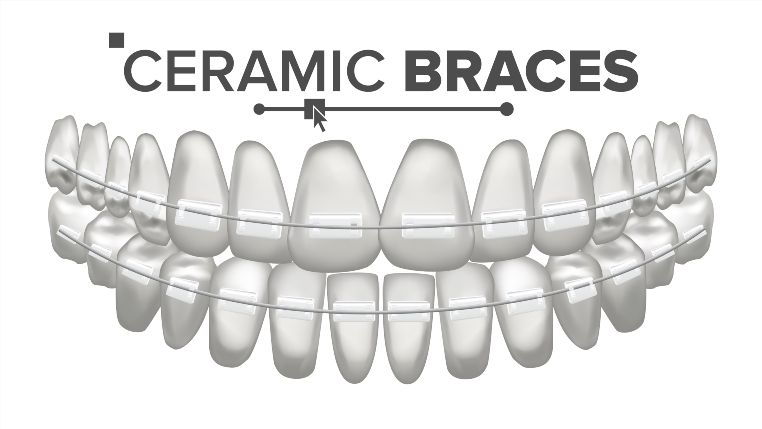Having aligned teeth and the correct bite is what makes your smile perfect. You know somebody who used to wear braces or probably wore it yourself. Whether you're a teenager or adult, there are lots of orthodontic braces and treatments you can choose from to get a healthy smile.
Ceramic braces, oftentimes called clear braces, are orthodontic tools used to fix bite problems and straighten teeth. They are made of tooth-coloured or clear ceramic brackets attached to the surface of your teeth. They also come with correspondingly coloured rubber bands and wires, which give more discretion.
The amount of time needed to fix the issues with your teeth using ceramic braces or some other material is more or less the same. The key difference between these orthodontic appliances lies in the fact that one is ceramic and the other is made of a different material.
Yet, they are not the same and every type of braces have their advantages and disadvantages. We wanted to shed some light on this topic, making it easier for you to decide which braces to choose.
Here's a quick analysis of the pros and cons of ceramic braces, particularly compared to standard metal braces.
Their visibility - The material used in ceramic braces can be clear or teeth-coloured. This makes them look natural and less visible.
Time of the treatment - Ceramic braces usually take between 18 and 36 months to straighten your teeth. Other clear-alignment methods like Invisalign, can take a year or longer to finish, which will affect their overall cost.
They are comfortable and less painful - People who have worn both ceramic and metal braces agree that ceramic teeth-aligners are less irritating and painful on your cheeks and gums because the ceramic is not as hard as metal.
They come in different colors - While metal braces usually come in grey or shiny metallic silver color, ceramic braces are made in almost any color possible.
Sometimes they cause gum sensitivity - Ceramic brackets are somewhat than metal brackets. This makes it more difficult for your toothbrush to clean around your brackets, which can lead to swollen or receding gums.
Their durability - Ceramic is slightly less durable than metal and more than twice times as likely to break. The process of debonding (removing the glue that holds ceramic braces) can cause damage to your enamel (tooth surface).
They adjust teeth lower than metal - Since they're fragile compared to metal, often incremental adjustments and broken brackets can increase the straightening process.
They can stain. The flexible ties securing the wire to the brackets may stain easily and stay dirty until they're removed and replaced.

When it comes to types of braces, adults and teenagers today have far more choices than ever before. Here are some different types of braces you might consider choosing:
Years ago, metallic braces used metal bands around almost every tooth. Today, conventional braces support wires with a single bracket that is joined on the front of your tooth. Wires in the back are anchored with a few bands. The other option for conventional braces replaces metal for ceramic - clear braces. Treatment time with conventional braces is usually the shortest and the most popular. Usually, after your treatment is finished you will have to wear retainers to help your teeth stay fixed in their new position.
Aligners are transparent trays that are changed every couple of weeks to provide the movement of teeth. They remain in the mouth for around 20 hours per day. They are removed for meals and brushing your teeth. The most familiar brand is Invisalign.
Aligners are less noticeable, but they are not invisible braces. Unlike some other types of braces, they won't affect flossing and brushing your teeth. Compared to conventional braces aligners demand a lot of discipline and regular changes of trays, which prolongs the treatment.
When it comes to self-ligating braces, the wire passes through a little metal clip on the support. This system reduces the need for elastic bands to aid the movement of the teeth. They are more comfortable than regular braces. They also need fewer adjustments and alterations.
Lingual braces are comparable to conventional braces, except the brackets are connected to the backside of teeth.
They work just as quickly as traditional braces. They are barely visible and the closest thing to hidden braces you can wear. Nevertheless, they are customized from person to person and usually cost more than other braces.
Compared to other braces aren't usually covered by dental insurance policies. You will probably have to obtain a separate orthodontic program. These programs differ widely for adults and children. This can influence the price and the length of treatment. The price of the treatment is also highly affected by the durability of braces. On average, from the time you put them on to the time they are removed; ceramic braces will cost you between $4000 and $8,000.

This question has as many answers as people who require proper braces. Ultimately, it is an individual decision that is affected by several factors:
Visibility of braces: if you don't care if your braces are visible you should choose metal braces. On the other hand, if you are shy or insecure about people seeing your braces you should pick ceramic braces because they blend better with your enamel. Other less obvious options you can use are lingual braces or aligners like Invisalign.
Self-discipline: Aligners are perfect if you are organized and self-disciplined enough to wear them 20 hours daily, taking them only for meals and while brushing your teeth. If you are not strict with yourself you should go for ceramic braces, metal braces, or lingual braces. They're not removable and you won't have to think twice about losing them.
Right treatment: Depending on how severe your dental issues for fixing are, this can determine the proper treatment and type of braces for you. Most of the problems can be solved with any type of braces. However, if you need to rotate your canine teeth or you have a misaligned jaw than metal braces are your only option. Although effective, aligners and other braces cannot fix complex dental problems. It is important to consult your orthodontist because he will give you the most accurate answer.
Cost: This is often a critical factor for patients looking for braces. If your budget doesn't allow you expensive choices, once again, metal braces are the most affordable. On the other hand, if the cost doesn't concern you, you should make your choice based on your preferences and lifestyle.
The short answer is yes, you can straighten teeth without braces. That pretty much depends on what type of treatment you need. Generally, if you want to fix minor orthodontic issues, slightly protruding teeth, or small gaps, your best option is Invisalign treatment. However, if you have a more complex problem that isn't fit for aligners, your orthodontist may suggest different braces. This may include ceramic and lingual braces as your best option. Although metal braces use the most force, they are still being considered the best option for some of the most challenging orthodontal problems. It is important to talk to your orthodontist before you opt for either ceramic, metal, or some other type of braces. One type might be extra effective for your teeth, even if it was not your first choice.

